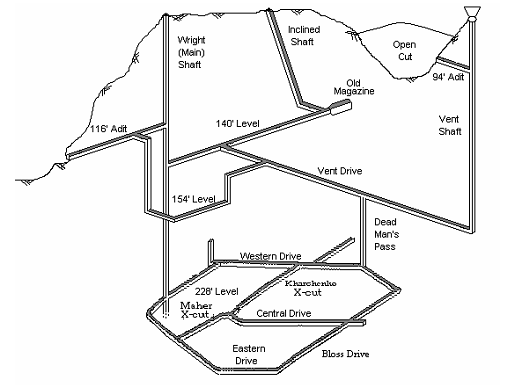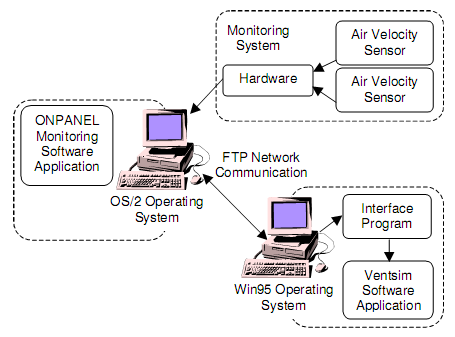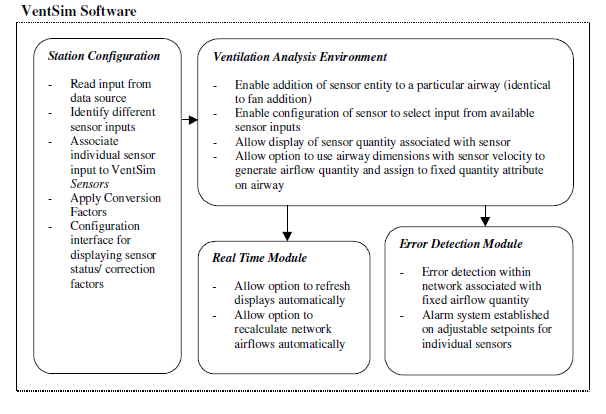
ABSTRACT
A research study is described that has developed a computerised monitoring and simulation system to provide immediate or real time information on each branch within an underground mine ventilation network through linking of sensors to the ventilation network simulation software. Software has been developed to link underground mine ventilation electronic sensor real time information into the network program to undertake network simulations and allow interpretation of key system data and operational changes.
The outcome of the project is an online system which can report changes in the mine ventilation system, allow causes of changes to be isolated and rectified, improve balancing of available air throughout the mine, dispense with much of the labour used for underground ventilation measurement and checking, improve power usage and assist emergency incident management.
The main work activities involved in the research program are described. These have involved software modification and considerable mine site installation, testing and optimising activities. The project has been supported by a number of operating companies and tested on their mine ventilation systems.
INTRODUCTION
As an important consideration for underground mining operations, ventilation network design and monitoring has been computerised. The fundamental requirement of ventilation is to provide controlled air distribution within the underground mining operations to satisfy statutory and safety requirements with respect to ventilation quantity and quality. Ventilation design then facilitates this distribution while using modelling and predictive tools. The analysis of an operational ventilation network during both normal and abnormal conditions can be very complicated both on a theoretical and analytical level, requiring computer based solutions. Monitoring systems provide the ability to observe many aspects of the underground environment simultaneously. The application of monitoring to the ventilation network has facilitated airflow, pressure, psychrometric and gas concentration observations.
It is proposed that through the integration of real time environmental monitoring and ventilation network analysis a system may be developed that facilitates the refinement of ventilation design and predictive modelling and provides an analysis of the operational ventilation network to identify abnormal conditions. The development of «what if» scenarios can then be simulated using a refined and more robust ventilation model with a higher degree of confidence in the predicted behaviours.
Real time control over a ventilation network can be achieved through the utilisation of modern control systems and controllable ventilation components. Integrated with a model representative of the actual ventilation conditions and identified airflow requirements, control and optimisation of the ventilation network may then be achieved with significant safety and economic benefits.
The purpose of this paper is to describe the research program and work completed in real time ventilation development.
PURPOSE OF RESEARCH
The aim of this mine ventilation research was to develop a computerised monitoring and control system to provide immediate or real time information on each branch within an underground ventilation network. The system measures airflow or air pressure changes in selected ventilation branches and simulate flows through all other branches. This new approach to ventilation provides improved understanding of airflows through all mine sections and allows quantification of peak, instantaneous and average readings and heat, gas or other contaminant levels for production purposes. It allows mine airflow balancing through parallel splits to be undertaken better. It serves as a useful aid to incident and emergency management. The popular ventilation simulation modelling program «Ventsim» has been used as a simulation engine within the system. This software has been altered to accept real time information generated by underground mine ventilation monitoring sensors, undertake network simulations and interpret key system data and operational changes.
Once the simulation program has updated readings it can remodel the whole mine ventilation system, report the flows in all branches and compare individual branch readings with expected values. If flows vary significantly, an alert signal can be initiated to question why the change has occurred.
The system is being developed to examine effects of heat and gas make on the ventilation system. Underground measurement and analysis of heat and gas concentrations with electronic transducers is well established. On a case study basis this data will be modified to a form that can be imported into computerised network analysis software. This will then allow maximum temperature and gas makes to be calculated by bringing together airflow and temperature and gas concentration readings.
The major utilisation benefits of the system are:
Trouble shooting that can detect any abnormal situation in the underground ventilation system directly indicating where the trouble is located (ie. indication of airway numbers) and what type of problem is involved (eg. insufficient air quantity, air short circuiting and major leakage paths).
Monitoring the air quantity and air quality in the return airway for determining the effectiveness of the ventilation design.
Detecting regulator failure or incorrect setting from a sudden increase of air velocity values and a decrease of differential pressure.
Detecting stopping or seal failure from changes in airflow and the resultant potential for gas migration or spontaneous combustion.
Detecting any blockage in the airway that will indicate the potential of roof, back or rib failure, or appropriate utilisation of equipment in the airway.
Monitoring goaf leakage due to sudden change of air velocity or air quantity and increase of gas contamination levels.
Providing an overall assessment of the fan performance in order to provide recommendations to alter the fan’s ventilation capacity to its optimal level, and consequently saving of costs. For example, if the current fan performance is higher than required according to the real time ventilation monitoring and simulation, the fan performance may be changed to a level that would be optimal for the current operation. As the underground workings are continuously developed, the fan performance can be gradually increased according to the ongoing real time monitoring assessment.
Providing an effective escape route when an emergency situation occurs and sending out the escape direction to all the underground personnel via an underground paging system.
Providing appropriate access and retreat routes for mine rescue teams.
Dispensing with considerable time expended by ventilation officers or their assistants in undertaking underground ventilation measurement and checking.
The objective of the current research is to develop and deliver a computerised real time mine ventilation monitoring and simulation system that can model dynamic situations and give real time understanding of mine airflows and possibly of contaminant levels both for production purposes and as an aid to incident and emergency management. The ventilation modelling and simulation program Ventsim has been adapted to accept real time mine ventilation information, reprogrammed to simulate mine conditions and put in a form to provide an immediate overview of the mine ventilation network performance.
VELOCITY SENSOR INTEGRATION
Aim of Research
The main aim of this section of research was to identify the extent of integration between ventilation network analysis programs and real time environmental monitoring and to facilitate the integration of the University of Queensland Experimental Mine (UQEM) telemetry system into the Ventsim network analysis environment. An isometric plan of the UQEM is shown in Figure 1.

Figure 1. Plan of University of Queensland Experimental Mine.
As part of this investigation the issues and complications that arose through the development of a real time analysis system were addressed such that this main aim was achieved. Initially the utilisation of ventilation quantity was integrated within the computer based network model of the UQEM, with scope for integration of gas concentration and pressure monitoring. The UQEM was then used to test the developed system in a real life scenario. The mine monitoring system included two vortex shedding air velocity sensors and various gas concentration sensors. For this exercise only the velocity sensors were incorporated into the integration. The aim of this testing was to initially use the system to monitor changing ventilation conditions, to establish airflow characteristics within the UQEM and to observe the resimulated network results. Further to this a procedure for utilising the system was established.
Achievement of the main research aim was facilitated with the development of a real time solution requiring data communication links between the various system components. These components included the UQEM telemetry monitoring system, the telemetry control software, the developed data manipulation applications, a File Transfer Protocol (FTP) application and a modified version of Ventsim.
System Integration
Conceptually two options existed at this stage for the real time monitoring integration; a direct telemetry communications scenario and the utilisation of a proprietary telemetry control software system. For the consideration of these options many factors were considered including the level of compatibility inherent in each system. A direct telemetry communications scenario would require programming software drivers that were already written and contained within the proprietary software installed. In addition, based on the development of an integrated solution that could be implemented over a wide variety of telemetry systems, utilisation of a proprietary system was chosen and hence the required links between the existing proprietary control system and the Windows 95 Ventsim environment were developed.
The three main objectives to this research were to undertake the:
Identification of the existing telemetry hardware and the method through which the control software communicates within this system.
Identification and development of communications links with monitoring software systems to request the sensor information, modify the information as requested, and provide this data to the Ventsim environment.
Modification of Ventsim such that monitoring capabilities are developed and enable network utilisation of this information.
Development of Communications Link: The link required to allow communication between the monitoring hardware and Ventsim was developed to satisfy only this particular installation. This solution arose from the problem of dealing with limited access to proprietary software and limited communication ability between the two different operating systems being utilised (OS/2 Warp – Monitoring System, Windows 95 – Ventsim). It was recognised that a more robust solution for industry was required and would be addressed later.
The final solution, schematically shown in Figure 2, was developed based on an industry standard network FTP running between two different personal computers each utilising one of the different operating systems. Periodically a packet of information (contained with a text file) was generated by the monitoring software and sent to the Windows 95 computer. Due to this solution information was only available to Ventsim periodically (typically at intervals greater than 30s) and was emulating a pseudo real time scenario.

Figure 2. Schematic Design of Final System Integration.
Ventsim Modifications: Due to the limitations in providing information to Ventsim the modifications were based around utilising a text file with the appropriate monitoring information. This information was a snapshot of the existing ventilation conditions and was up to 30s old by the time this file was made available to the Windows 95 PC.
In Figure 3 the basis for modifications to Ventsim are described. At this stage the modifications were kept as simple as possible to allow for testing of a robust initial design.

Figure 3. Ventsim Real Time Integration Modifications
CONCLUSION
The use of computer applications as productive tools in mining is constantly increasing. Real time ventilation monitoring and computer based network analysis is one area in which much effort is being focused. The operational safety and productivity benefits can be demonstrated easily but require a lengthy development and implementation process. The developments achieved to date are steps in the ultimate development of a fully automated ventilation network through the use of monitoring, modelling and control systems.
Arakawa, M., Takahashi, K., Tominaga, Y., Umeki, Y. (1989). The application of an expert system to control mine ventilation at the Taiheiyo coal mine under the open sea. In Proceedings of the 4th US Mine Ventilation Symposium (Ed: McPherson M.J.), pp 317-321 (Society of Mining, Metallurgy, and Exploration: Colorado).
Firganek, B. (1988). Environmental Monitoring in Polish Coal Mines. In proceedings of the Fourth International Mine Ventilation Congress (Ed: Gillies A.D.S.), pp 45-52 (The Australasian Institute of Mining and Metallurgy: Melbourne).
Hardcastle, S.G. (1995). 3D-CANVENT: An interactive Mine Ventilation Simulator. In proceedings of the 7th US Mine Ventilation Symposium (Ed: Wala A.M.), pp 467-472 (Society of Mining, Metallurgy, and Exploration: Colorado).
Hatakeyama, Y., Inoue, M., Kimura, Y., Sakai, T. (1992). Real Time Ventilation Network Analysis Based on Anemometers in an Underground Coal Mine, pp 345-350.
Katoh, T., Ono, S., Tominaga, Y. (1995). An Integrated System to Control Airflow Rate Distribution in a Complicated Ventilation Network, in proceedings of the 7th US Mine Ventilation Symposium (Ed: Wala A.M.), pp 473-478 (Society of Mining, Metallurgy, and Exploration: Colorado).
Ketler, A.E. (1997). Windows Based Computer Data Acquisition and Control System Provides Cost/Performance Benefits for Mine-Wide Monitoring. In proceedings of the 6thInternational Mine Ventilation Congress (Ed: Ramani R.V.), pp 77-81 (Society of Mining, Metallurgy, and Exploration: Colorado).
McDaniel, K.H., Strever, M.T., Wallace, K.G. (1995). Underground Ventilation Remote Monitoring and Control System. In proceedings of the 7th US Mine Ventilation Symposium (Ed: Wala A.M.), pp 69-74 (Society of Mining, Metallurgy, and Exploration: Colorado).
McDaniel, K.H., Wallace, K.G. (1997). Real Time Mine Ventilation Simulation, Mining Engineering, pp 71-75.